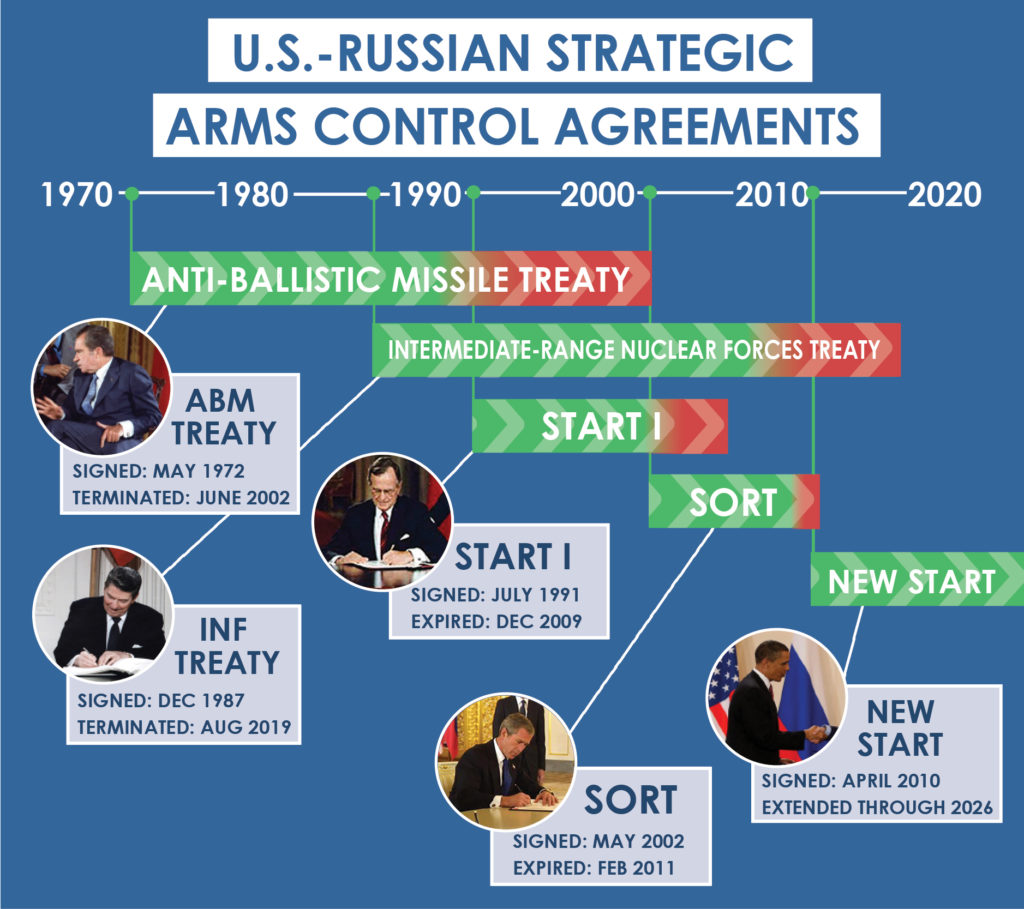 Learn more about Russia’s war in Ukraine.
Learn more about Russia’s war in Ukraine.
Four years after the United States first tested and used nuclear weapons, the Soviet Union ushered in a new nuclear era with its first nuclear test on August 29, 1949. Within a few years, the arms race was in full steam as the Soviets grew their arsenal and conducted 715 atmospheric and underground nuclear tests from 1949-1990. At its peak in 1986, the Soviet Union had around 40,000 nuclear warheads in its stockpile.
Through a number of bilateral arms control agreements with the United States at the end of and after the Cold War, the Russian arsenal was reduced significantly. Today, Russia maintains a stockpile of an estimated 6,372 nuclear warheads, 1,572 of which are deployed on strategic land-based ballistic missiles, submarine-launched ballistic missiles, and heavy bombers. Approximately 870 more strategic warheads and 1,870 non-strategic warheads are in reserve with an additional estimated 2,060 warheads awaiting dismantlement.
Russia and the United States together still hold more than 90% of the world’s nuclear arsenal, however, so it is imperative to maintain civil relations between the two countries to reduce the number of nuclear weapons and eliminate the risk of nuclear war. For decades, U.S. presidents and Members of Congress from both parties have supported verifiable arms control treaties beginning with the Nuclear Test Ban Treaty through the START treaties. With the end of the Soviet Union, significant focus was placed on reducing fissile materials in Russia through the Nunn-Lugar Cooperate Threat Reduction (CTR) program and eliminating nuclear weapons from the former Soviet states of Ukraine, Belarus, and Kazakhstan.
Today, with U.S.-Russian relations at a post-Cold War low, and as both countries modernize their nuclear arsenals, the reality of a new nuclear arms race underscores the need for sensible non-proliferation and arms control cooperation. Despite this, the Trump administration withdrew from a number of critical arms control agreements, including the Intermediate-Range Nuclear Forces (INF) Treaty and the Open Skies Treaty. In early 2021, the Biden administration reached an agreement with Russia to extend the New START treaty until February 2026, the only remaining arms control treaty between the world’s two largest arsenals. With this extension in place, the United States and Russia should begin talks to expand on further mutual reductions and other areas of concern, including non-strategic nuclear weapons, missile defenses, and other emerging technologies.
Unfortunately, Russian President Vladimir Putin declared in late February 2023 that Russia was “suspending” its participation in New START. He framed the step as necessary given (imagined) U.S. provocations, but in reality it merely confirmed what was already Russian policy. This announcement followed a series of implementation issues. The United States determined that Russia was not in compliance with the treaty in January 2023. A State Department Spokesperson explained, “Russia’s refusal to facilitate inspection activities prevents the United States from exercising important rights under the treaty and threatens the viability of US-Russian nuclear arms control.” In August 2022, the Kremlin blocked treaty-bound inspections visits to its facilities and in November 2022, Moscow postponed the treaty’s bilateral consultative commission. As yet, there has been no finding of a material breach of treaty limits, and Russia and the United States remain below the 2018 deployment limits.
Recent News and Analysis on Russia
- Op-ed: What Sweden, Finland, and Poland can teach the United States about confronting Russia’s nuclear threats April 11, 2025
- Op-ed: North Korean Forces in Ukraine: What it Means and What to Do April 10, 2025
- Good Idea, Iffy Prospects March 28, 2025
- STATEMENT ON TRUMP-ZELENSKYY OVAL OFFICE MEETING February 28, 2025
- 3 Years Later: 5 Problems With Forcing a Ceasefire February 24, 2025
- Op-ed: North Korea in Ukraine: What It Means for the World February 1, 2025
- The Baltic Blueprint: A Modern Approach to NATO’s Deterrence January 24, 2025
- Does Putin’s New ‘Oreshnik’ Missile Transform Rules of Nuclear Warfare? December 13, 2024
- The Fall of Assad: A Cautionary Tale for Kim Jong Un December 12, 2024
- Could Putin Use a Nuclear Weapon in Ukraine? 3 Experts Weigh In November 27, 2024
